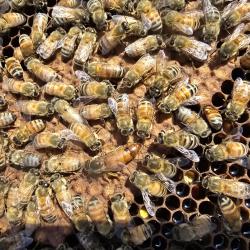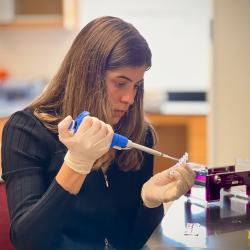UMD Student Scientists Take on West Nile Virus

Six undergraduates gained hands-on research experience studying the mosquitoes that carry and spread West Nile virus.
In spring 2025, a team of University of Maryland undergraduates spent the semester doing something most people would find revolting: collecting mosquito eggs and larvae from buckets of fermented, stinky water strategically placed around the College Park campus.
Working alongside Entomology Associate Professor Megan Fritz and Ph.D. candidate Benjamin Gregory, biological sciences majors Marcelina Castleberry, Niina Craven, Samantha Frink, Nicole Guzman, Ayesha Khan and Eesha Patel studied how different mosquito species and their young offspring respond to changes in temperature. Their research could lead to better models that predict when and where mosquito-borne diseases, like West Nile virus, can break out. Although most cases of West Nile virus are found in warmer climates, scientists worry that the disease will expand beyond its natural ranges due to higher average temperatures and urbanization. As of September 2025, 37 states have reported cases of West Nile virus and Fritz noted that more may come as summer transitions into fall.
“West Nile is currently one of the most common mosquito-borne diseases in North America, with cases reported across the U.S. every year,” Fritz said. “It made headlines more recently when Anthony Fauci was hospitalized with West Nile virus infection in Maryland during fall of last year. For people who are symptomatic, the disease can have significant health consequences.”
Understanding the enemy
Fritz’s research group focused on two common mosquito species that can transmit West Nile virus: Culex restuans and Culex pipiens. Despite sharing the same genus, the two mosquito species have distinctly different behaviors.

“[Culex] restuans primarily feed on birds and prefer natural environments, appearing mainly in spring and early summer,” Gregory explained. “[Culex] pipiens is a little less discriminating. They tend to bite both birds and people, thrive in urban settings and become more abundant later in the season. [Culex] pipiens are particularly suited to city life because they can exploit urban infrastructure, finding cracks and crevices to hang out in and make it through the winter months.”
According to Gregory, when both species become abundant at the same time, West Nile virus cases may spike in human populations. But he needed more data to create more accurate mathematical models of the phenomenon, which is where the undergraduates came in. Led by Gregory, they started their work by setting ovipositional mosquito traps using black plastic bins filled with alfalfa hay-infused water.
“Every morning, we collected the egg clusters of mosquitoes attracted to the stagnant, stinky water, separated them carefully in the lab and waited for them to hatch,” said Castleberry, a senior specializing in general biology. “After that, we tested their thermal tolerance of a range of gradually increasing temperatures from 97°F to 115°F, observed their behavior and determined their survival rates.”
The undergrads then extracted DNA from the mosquito samples using techniques like polymerase chain reaction amplification and gel electrophoresis to identify the species in each sample. By the end of the semester, the team found that Culex pipiens (the urban-adapted species) showed greater heat tolerance than Culex restuans (the species that prefers natural areas) and that most of the samples collected in early spring were restuans, confirming that the species was active earlier in the season.
Building new avenues of research
For the undergraduates, the experience went far beyond just learning basic technical skills in a lab.
“We learned about everything that comes in handy with professional research and it made me contemplate a career path beyond just going to medical school,” explained Castleberry, who started a cardiology internship at Louisiana State University in Shreveport in mid-June. “For example, we were encouraged to take the opportunity of just reading literature in this research niche and then processing it before going out into the field. That was extremely helpful in preparing us for doing professional-level scientific work afterward and knowing what to expect.”
Inspired by her time in Fritz’s lab, Frink recently began an internship at Vectech, an organization running the world’s first AI-enabled entomology diagnostic system. The sophomore said that the team’s research sparked her interest in biological vectors and epidemiology and she hopes to pursue similar work in the future.

“Working in the group was instrumental in prompting me to apply to my internship and in developing the skills and knowledge necessary to succeed at it,” Frink said. “Like many other undergrads, I used to think that I didn’t have enough experience to work in a lab, but this showed me that many researchers are willing to accommodate. All you need to bring is a willingness to learn and a positive attitude.”
Guzman agrees. The senior found that the skills she learned from the Fritz lab transferred smoothly to her current marine biology internship, and the experience gave her a much-needed peek into the realities of scientific research.
“What we’ve learned doesn’t just apply to mosquitoes or insects. Many of the protocols and techniques that I use now to study with seagrass are built off of what I already learned in the Fritz lab dealing with mosquitoes,” she said. “And even just a failed experiment or finding nothing is important. We learned that a zero is still a useful data point.”
Thanks to the students’ work, researchers are a step closer to improving how they track vector-borne diseases like West Nile virus as they spread. Fritz hopes that undergraduates across all STEM fields will continue to seek ways to contribute to research addressing public health problems and other challenges, as this team has.
“This was a chance for us to show undergraduates that they can contribute meaningfully to important problems in the real world, especially public health challenges,” Fritz said. “They learned valuable lab skills while generating data that scientists can use to build better models for predicting West Nile virus outbreaks—research that could help save lives.”







